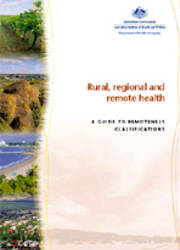Summary
Policy makers, researchers and the general community are interested in the ways that the lives of Australians vary according to where they live. For example:
- There has been an increasing concern over a number of years about perceived difficulties faced by Australians living outside major metropolitan centres in accessing services (DHAC & GISCA 2001).
- There has also been particular concern about possible differences in health, education, income and a range of other factors, between those living in and those living outside major metropolitan centres. For example, a newly released report, Rural, Regional and Remote Health: A Study on Mortality (AIHW 2003), showed that, during the period 1997–1999, the mortality rates for people in regional and remote areas were higher than for people in capital cities.
Analyses of such differences depend on the ability to classify areas according to their remoteness. Three major remoteness classifications are currently used:
- The RRMA (Rural, Remote and Metropolitan Areas) classification
- The ARIA (Accessibility/Remoteness Index of Australia) classification (based on ARIA index values), and
- ASGC (Australian Standard Geographical Classification) Remoteness Areas (based on ARIA+ index values—an enhanced version of the ARIA index values).
This publication reviews these three classifications, their methodologies, and their strengths and weaknesses, and describes how the classifications are applied to administrative and survey data.
-
Preliminary material
-
Introduction
-
The remoteness classifications
-
Strengths and weaknesses of the three methodologies and classifications
-
The practical limitations of remoteness classifications
-
The geographical guide - SLAs and the three remoteness classifications
End matter: Acknowledgments; Abbreviations; Explanatory notes; Geography; Terminology; Glossary; References; List of tables; List of figures



